View in other NatureServe Network Field Guides
NatureServe
Montana
Utah
Wyoming
Idaho
Wisconsin
British Columbia
South Carolina
Yukon
California
New York
Ponderosa Pine - Pinus ponderosa
Other Names:
Pinus scopulorum
Native Species
Global Rank:
G5
State Rank:
S5
(see State Rank Reason below)
C-value:
4
Agency Status
USFWS:
USFS:
BLM:
External Links
State Rank Reason (see State Rank above)
Widespread and abundant across low-elevations in most of Montana.
- Details on Status Ranking and Review
Population Size
Score0 - Large: Generally >100,000 individuals.
Range Extent
Score0 - Widespread species within Montana (occurs in 5% or more of the state or generally occurring in 6 or more sub-basins.) as well as outside of Montana.
Area of Occupancy
Score0 - High: Occurs in >25 Subwatersheds (6th Code HUC’s).
Environmental Specificity
Score0 - Low: Species is a generalist that occurs in a variety of habitats and/or is tolerant of disturbed or degraded habitats (C -Values of 1-4).
Trends
ScoreNA - Rank factor not assessed.
Threats
Score0 - Low: Impacts, if any, to the species are expected to be minor or insignificant (affecting <10% of populations) in severity, scope and immediacy.
Intrinsic Vulnerability
Score0 - Low Vulnerability: Species does not have any unusual or specific life history or biological attributes or limted reproductive potential which makes it susceptible to extirpation from stochastic events or other adverse impacts to its habitat and thus slow to recover.
Raw Conservation Status Score
Score
0 points scored out of a possible 16 (Rarity factors and threats only).
General Description
Large trees to 65 m tall with an open, rounded crown and spreading branches. Bark of old trees thick, furrowed, covered with scales that resemble pieces of a jigsaw puzzle. Leaves yellow-green, 7–25 cm long, 2–3 per fascicle, clustered on branch ends. Seed cones broadly ovoid, 7–15 cm long. Scales thick with a terminal prickle. Seeds with a conspicuous wing. Our plants are var. scopulorum (
Lesica et al. 2012. Manual of Montana Vascular Plants. BRIT Press. Fort Worth, TX).
Species Range
Montana Range
Range Descriptions
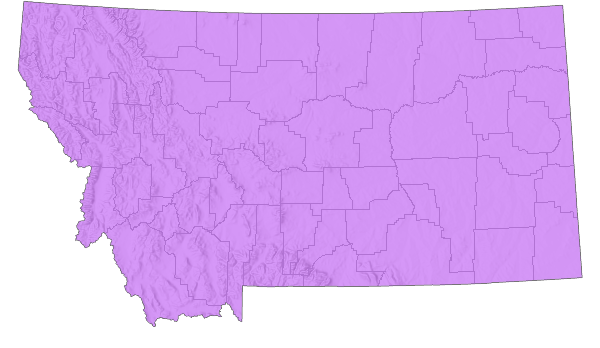
 Native
Native
Range Comments
Across most of MT; BC to NE south to Mexico (Lesica et al. 2012. Manual of Montana Vascular Plants. BRIT Press. Fort Worth, TX).
Observations in Montana Natural Heritage Program Database
Number of Observations: 7245
(Click on the following maps and charts to see full sized version)
Map Help and Descriptions
Relative Density
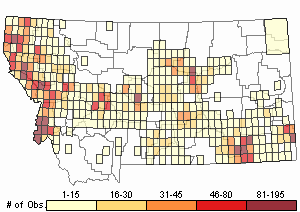
Recency
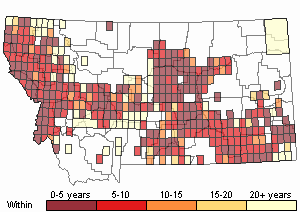

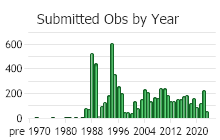
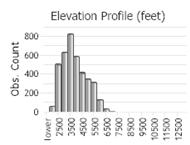 (Observations spanning multiple months or years are excluded from time charts)
(Observations spanning multiple months or years are excluded from time charts)
Habitat
Drier forests as well as rocky exposures (especially sandstone) associated with grasslands; plains, valleys to montane (
Lesica et al. 2012. Manual of Montana Vascular Plants. BRIT Press. Fort Worth, TX).
National Vegetation Classification System Groups Associated with this Species
Forest and Woodland
Low Elevation - Xeric Forest and Woodland
Montane - Subalpine Forest and Woodland
Wetland and Riparian
Riparian and Wetland Forest
Stewardship Responsibility
References
- Literature Cited AboveLegend:
 View Online Publication
View Online Publication Lesica, P., M.T. Lavin, and P.F. Stickney. 2012. Manual of Montana Vascular Plants. Fort Worth, TX: BRIT Press. viii + 771 p.
Lesica, P., M.T. Lavin, and P.F. Stickney. 2012. Manual of Montana Vascular Plants. Fort Worth, TX: BRIT Press. viii + 771 p.
- Additional ReferencesLegend:
 View Online Publication
View Online Publication
Do you know of a citation we're missing? Aldrich, D. F. 1978. Overwintering, springtime development and migration of some Aphidea, including Myzus persicae of Northwestern Montana. M.Sc. Thesis. Bozeman, Montana: Montana State University. 112 p.
Aldrich, D. F. 1978. Overwintering, springtime development and migration of some Aphidea, including Myzus persicae of Northwestern Montana. M.Sc. Thesis. Bozeman, Montana: Montana State University. 112 p. Anderson, N.L. 1962. Grasshopper-vegetation relationships on Montana grasslands. Ph.D Dissertation. Bozeman, Montana: Montana State University. 73 p.
Anderson, N.L. 1962. Grasshopper-vegetation relationships on Montana grasslands. Ph.D Dissertation. Bozeman, Montana: Montana State University. 73 p. Burkle L.A., M.P. Simanonok, J.S. Durney, J.A. Myers, and R.T. Belote. 2019. Wildfires influence abundance, diversity, and intraspecific and interspecific trait variation of native bees and flowering plants across burned and unburned landscapes. Frontiers in Ecology and Evolution 7(252):1-14.
Burkle L.A., M.P. Simanonok, J.S. Durney, J.A. Myers, and R.T. Belote. 2019. Wildfires influence abundance, diversity, and intraspecific and interspecific trait variation of native bees and flowering plants across burned and unburned landscapes. Frontiers in Ecology and Evolution 7(252):1-14. Cope, M.G. 1992. Distribution, habitat selection and survival of transplanted Columbian Sharp-tailed Grouse (Tympanuchus phasianellus columbianus) in the Tobacco Valley, Montana. M.Sc. Thesis. Bozeman, Montana: Montana State University. 60 p.
Cope, M.G. 1992. Distribution, habitat selection and survival of transplanted Columbian Sharp-tailed Grouse (Tympanuchus phasianellus columbianus) in the Tobacco Valley, Montana. M.Sc. Thesis. Bozeman, Montana: Montana State University. 60 p. DuBois, K.L. 1979. An inventory of the avifauna in the Long Pines of Southeastern Montana. M.Sc. Thesis. Bozeman, MT: Montana State University. 113 p.
DuBois, K.L. 1979. An inventory of the avifauna in the Long Pines of Southeastern Montana. M.Sc. Thesis. Bozeman, MT: Montana State University. 113 p. Egan, J.L. 1957. Some relationships between mule deer and alfalfa production in Powder River County, Montana. M.Sc. Thesis. Bozeman, MT: Montana State University. 34 p.
Egan, J.L. 1957. Some relationships between mule deer and alfalfa production in Powder River County, Montana. M.Sc. Thesis. Bozeman, MT: Montana State University. 34 p. Endicott, C.L. 1996. Responses of riparian and stream ecosystems to varying timing and intensity of livestock grazing in central Montana. M.Sc. Thesis. Bozeman, MT: Montana State University. 115 p.
Endicott, C.L. 1996. Responses of riparian and stream ecosystems to varying timing and intensity of livestock grazing in central Montana. M.Sc. Thesis. Bozeman, MT: Montana State University. 115 p. Enk, E.A. 1999. Population dynamics of bighorn sheep on the Beartooth Wildlife Management Area, Montana. Ph.D. Dissertation. Bozeman, MT: Montana State University. 177 p.
Enk, E.A. 1999. Population dynamics of bighorn sheep on the Beartooth Wildlife Management Area, Montana. Ph.D. Dissertation. Bozeman, MT: Montana State University. 177 p. Fogelsong, M.L. 1974. Effects of fluorides on Peromyscus maniculatus in Glacier National Park. M.Sc. Thesis. Bozeman, Montana: Montana State University. 52 p.
Fogelsong, M.L. 1974. Effects of fluorides on Peromyscus maniculatus in Glacier National Park. M.Sc. Thesis. Bozeman, Montana: Montana State University. 52 p. Fritzen, D.E. 1995. Ecology and behavior of Mule Deer on the Rosebud Coal Mine, Montana. Ph.D. Dissertation. Bozeman, MT: Montana State University. 143 p.
Fritzen, D.E. 1995. Ecology and behavior of Mule Deer on the Rosebud Coal Mine, Montana. Ph.D. Dissertation. Bozeman, MT: Montana State University. 143 p. Fultz, J.E. 2005. Effects of shelterwood management on flower-visiting insects and their floral resources. M.Sc. Thesis. Bozeman, MT: Montana State University. 163 p.
Fultz, J.E. 2005. Effects of shelterwood management on flower-visiting insects and their floral resources. M.Sc. Thesis. Bozeman, MT: Montana State University. 163 p. Gaffney, W.S. 1941. The effects of winter elk browsing, South Fork of the Flathead River, Montana. Journal of Wildlife Management 5(4):427-453.
Gaffney, W.S. 1941. The effects of winter elk browsing, South Fork of the Flathead River, Montana. Journal of Wildlife Management 5(4):427-453. Gobeille, J.E. 1992. The effect of fire on Merriams turkey brood habitat in southeastern Montana. M.Sc. Thesis. Bozeman, MT: Montana State University. 61 p.
Gobeille, J.E. 1992. The effect of fire on Merriams turkey brood habitat in southeastern Montana. M.Sc. Thesis. Bozeman, MT: Montana State University. 61 p. Harvey, S.J. 1990. Responses of steppe plants to gradients of water soil texture and disturbance in Montana, U.S.A. Ph.D. Thesis. Bozeman, MT: Montana State University. 34 p.
Harvey, S.J. 1990. Responses of steppe plants to gradients of water soil texture and disturbance in Montana, U.S.A. Ph.D. Thesis. Bozeman, MT: Montana State University. 34 p. Hendricks, P. 2005. Surveys for animal species of concern in northwestern Montana. Unpublished report to the Montana Department of Fish, Wildlife & Parks, Montana Natural Heritage Program, Helena, Montana, May 2005. 53 p.
Hendricks, P. 2005. Surveys for animal species of concern in northwestern Montana. Unpublished report to the Montana Department of Fish, Wildlife & Parks, Montana Natural Heritage Program, Helena, Montana, May 2005. 53 p. Holbrook, J.D., J.R. Squires, L.E. Olson, N.J. DeCesare, and R.L. Lawrence. 2017. Understanding and predicting habitat for wildlife conservation: the case of Canada Lynx at the range periphery. Ecosphere 8(9):e01939.
Holbrook, J.D., J.R. Squires, L.E. Olson, N.J. DeCesare, and R.L. Lawrence. 2017. Understanding and predicting habitat for wildlife conservation: the case of Canada Lynx at the range periphery. Ecosphere 8(9):e01939. Holeckek, J.L. 1976. Initial effects of different species treatments and fertilizer rates on a mine spoils rehabilitation. M.Sc. Thesis. Bozeman, MT: Montana State University. 91 p.
Holeckek, J.L. 1976. Initial effects of different species treatments and fertilizer rates on a mine spoils rehabilitation. M.Sc. Thesis. Bozeman, MT: Montana State University. 91 p. Howard, J. L. 2003. Pinus ponderosa var. scopulorum. In: Fire Effects Information System, [Online}. U. S. Department of Agriculture, Forest Service, Rocky Mountain Research Station, Fire Sciences Laboratory.
Howard, J. L. 2003. Pinus ponderosa var. scopulorum. In: Fire Effects Information System, [Online}. U. S. Department of Agriculture, Forest Service, Rocky Mountain Research Station, Fire Sciences Laboratory. Johnson, T. W. 1982. An analysis of pack and saddle stock grazing areas in the Bob Marshall Wilderness. M.Sc.Thesis. Bozeman, MT: Montana State University. 105 p.
Johnson, T. W. 1982. An analysis of pack and saddle stock grazing areas in the Bob Marshall Wilderness. M.Sc.Thesis. Bozeman, MT: Montana State University. 105 p. King, L.A. 1980. Effects of topsoiling and other reclamation practices on nonseeded species establishment on surface mined land at Colstrip, Montana. M.Sc. Thesis. Bozeman, MT: Montana State University. 129 p.
King, L.A. 1980. Effects of topsoiling and other reclamation practices on nonseeded species establishment on surface mined land at Colstrip, Montana. M.Sc. Thesis. Bozeman, MT: Montana State University. 129 p. Kisch, H.R. 2015. An inventory of carbon stocks under native vegetation and farm fields in south-central Montana. M.Sc. Thesis. Bozeman, MT: Montana State University. 67 p.
Kisch, H.R. 2015. An inventory of carbon stocks under native vegetation and farm fields in south-central Montana. M.Sc. Thesis. Bozeman, MT: Montana State University. 67 p. Kitchen, K.A. 2010. The influence of Douglas-fir and Rocky Mountain juniper on Wyoming and mountain big sagebrush cover in southwest Montana. M.Sc. Thesis. Bozeman, MT: Montana State University. 87 p.
Kitchen, K.A. 2010. The influence of Douglas-fir and Rocky Mountain juniper on Wyoming and mountain big sagebrush cover in southwest Montana. M.Sc. Thesis. Bozeman, MT: Montana State University. 87 p. Klebenow, D.A. 1965. A montane forest winter deer habitat in western Montana. Journal of Wildlife Management 29(1):27-33.
Klebenow, D.A. 1965. A montane forest winter deer habitat in western Montana. Journal of Wildlife Management 29(1):27-33. Kosterman, M.K., J.R. Squires, J.D. Holbrook, D.H. Pletscher, and M. Hebblewhite. 2018. Forest structure provides the income for reproductive success in a southern population of Canada Lynx. Ecological Applications 28(4):1032-1043.
Kosterman, M.K., J.R. Squires, J.D. Holbrook, D.H. Pletscher, and M. Hebblewhite. 2018. Forest structure provides the income for reproductive success in a southern population of Canada Lynx. Ecological Applications 28(4):1032-1043. Lesica, P., M.T. Lavin, and P.F. Stickney. 2022. Manual of Montana Vascular Plants, Second Edition. Fort Worth, TX: BRIT Press. viii + 779 p.
Lesica, P., M.T. Lavin, and P.F. Stickney. 2022. Manual of Montana Vascular Plants, Second Edition. Fort Worth, TX: BRIT Press. viii + 779 p. Little, E.L., Jr. 1979. Checklist of United States trees (native and naturalized). Agriculture Handbook No. 541. U.S. Forest Service, Washington, D.C. 375 pp.
Little, E.L., Jr. 1979. Checklist of United States trees (native and naturalized). Agriculture Handbook No. 541. U.S. Forest Service, Washington, D.C. 375 pp. Lovaas, A.L. 1957. Mule deer food habits and range use in the Little Belt Mountains, Montana. M.Sc. Thesis. Bozeman, MT: Montana State University. 43 p.
Lovaas, A.L. 1957. Mule deer food habits and range use in the Little Belt Mountains, Montana. M.Sc. Thesis. Bozeman, MT: Montana State University. 43 p. Lunan, J.S. 1972. Phytosociology and fuel description of Pinus ponderosa communities in Glacier National park. M.S. thesis. Department of Botany, University of Montana, Missoula. 79 pp.
Lunan, J.S. 1972. Phytosociology and fuel description of Pinus ponderosa communities in Glacier National park. M.S. thesis. Department of Botany, University of Montana, Missoula. 79 pp. MacCracken, J.G. and D.W. Uresk. 1984. Big game habitat use in southeastern Montana. The Prairie Naturalist 16(3):135-139.
MacCracken, J.G. and D.W. Uresk. 1984. Big game habitat use in southeastern Montana. The Prairie Naturalist 16(3):135-139. Martin, P.R. 1973. Ecology of skunkbrush sumac (Rhus trilobata Nutt.) in Montana with special reference to use by mule deer. M.Sc. Thesis. Bozeman, MT: Montana State University. 97 p.
Martin, P.R. 1973. Ecology of skunkbrush sumac (Rhus trilobata Nutt.) in Montana with special reference to use by mule deer. M.Sc. Thesis. Bozeman, MT: Montana State University. 97 p. Martinka, R.R. 1970. Structural characteristics and ecological relationships of male blue grouse (Dendragapus obscurus (Say)) territories in southwestern Montana. Ph.D Dissertation. Bozeman, MT: Montana State University. 73 p.
Martinka, R.R. 1970. Structural characteristics and ecological relationships of male blue grouse (Dendragapus obscurus (Say)) territories in southwestern Montana. Ph.D Dissertation. Bozeman, MT: Montana State University. 73 p. Maxwell, B.D. 1984. Changes in an infested plant community after an application of picloram, the effect of glyphosate on bud dormancy, the effect of pulling and the fuel potential of leafy spurge (Euphorbia esula L.). M.Sc. Thesis. Bozeman, MT: Montana State University. 73 p.
Maxwell, B.D. 1984. Changes in an infested plant community after an application of picloram, the effect of glyphosate on bud dormancy, the effect of pulling and the fuel potential of leafy spurge (Euphorbia esula L.). M.Sc. Thesis. Bozeman, MT: Montana State University. 73 p. Meier, G.A. 1997. The colonization of Montana roadsides by native and exotic plants. M.Sc. Thesis. Bozeman, MT: Montana State University. 45 p.
Meier, G.A. 1997. The colonization of Montana roadsides by native and exotic plants. M.Sc. Thesis. Bozeman, MT: Montana State University. 45 p. Miller, J.G. 1978. An ecoligical study of creeping juniper (Juniperus horizontalis Moench.) in Montana. M.Sc. Thesis. Bozeman, MT: Montana State University. 154 p.
Miller, J.G. 1978. An ecoligical study of creeping juniper (Juniperus horizontalis Moench.) in Montana. M.Sc. Thesis. Bozeman, MT: Montana State University. 154 p. Mosher, B.A. 2011. Avian community response to a mountain beetle epidemic. M.Sc. Thesis. Bozeman, MT: Montana State University. 55 p.
Mosher, B.A. 2011. Avian community response to a mountain beetle epidemic. M.Sc. Thesis. Bozeman, MT: Montana State University. 55 p. Nelson, G.P. 1986. Responses of elk to a 500 kV transmission line on the North Boulder winter range, Montana. M.Sc. Thesis. Bozeman, MT: Montana State University. 60 p.
Nelson, G.P. 1986. Responses of elk to a 500 kV transmission line on the North Boulder winter range, Montana. M.Sc. Thesis. Bozeman, MT: Montana State University. 60 p. Northrup, R.D. 1991. Sharp-tailed grouse habitat use during fall and winter on the Charles M. Russell National Wildlife Refuge, Montana. M.Sc. Thesis. Bozeman, MT: Montana State University. 54 p.
Northrup, R.D. 1991. Sharp-tailed grouse habitat use during fall and winter on the Charles M. Russell National Wildlife Refuge, Montana. M.Sc. Thesis. Bozeman, MT: Montana State University. 54 p. Plantenberg, P.L. 1983. Factors affecting vegetation development on mined land at Colstrip, Montana. M.Sc. Thesis. Bozeman, MT: Montana State University. 121 p.
Plantenberg, P.L. 1983. Factors affecting vegetation development on mined land at Colstrip, Montana. M.Sc. Thesis. Bozeman, MT: Montana State University. 121 p. Reese, E.G., L.A. Burkle, C.M. Delphia, and T. Griswold. 2018. A list of bees from three locations in the Northern Rockies Ecoregion (NRE) of western Montana. Biodiversity Data Journal 6: e27161.
Reese, E.G., L.A. Burkle, C.M. Delphia, and T. Griswold. 2018. A list of bees from three locations in the Northern Rockies Ecoregion (NRE) of western Montana. Biodiversity Data Journal 6: e27161. Reichel, J.D., D.L. Genter and E. Atkinson. 1992. Sensitive animal species in the Elkhorn and Big Belt Mountains of the Helena National Forest. Unpublished report to the Helena National Forest. Montana Natural Heritage Program, Helena. 158 p.
Reichel, J.D., D.L. Genter and E. Atkinson. 1992. Sensitive animal species in the Elkhorn and Big Belt Mountains of the Helena National Forest. Unpublished report to the Helena National Forest. Montana Natural Heritage Program, Helena. 158 p. Rennick, R.B. 1981. Effects of prescribed burning on mixed prairie vegetation in southeastern Montana. M.Sc. Thesis. Bozeman, MT: Montana State University. 144 p.
Rennick, R.B. 1981. Effects of prescribed burning on mixed prairie vegetation in southeastern Montana. M.Sc. Thesis. Bozeman, MT: Montana State University. 144 p. Schomburg, J.W. 2003. Development and evaluation of predictive models for managing Golden Eagle electrocutions. M.Sc. Thesis. Bozeman, MT: Montana State Universtiy. 98 p.
Schomburg, J.W. 2003. Development and evaluation of predictive models for managing Golden Eagle electrocutions. M.Sc. Thesis. Bozeman, MT: Montana State Universtiy. 98 p. Schubloom, L.A. 1995. Lichens as air quality indicators in three areas of southwestern Montana: lichen floristics and elemental analysis. M.Sc. Thesis. Bozeman, MT: Montana State University. 130 p.
Schubloom, L.A. 1995. Lichens as air quality indicators in three areas of southwestern Montana: lichen floristics and elemental analysis. M.Sc. Thesis. Bozeman, MT: Montana State University. 130 p. Scow, K.L. 1981. Ecological distribution of small mammals at Sarpy Creek, Montana, with special consideration of the Deer Mouse, Peromyscus maniculatus. M.Sc. Thesis. Bozeman, Montana: Montana State University. 73 p.
Scow, K.L. 1981. Ecological distribution of small mammals at Sarpy Creek, Montana, with special consideration of the Deer Mouse, Peromyscus maniculatus. M.Sc. Thesis. Bozeman, Montana: Montana State University. 73 p. Selting, J.P. 1994. Seasonal use of agricultural lands by Mule Deer, White-Tailed Deer, and Pronghorn Antelope in Carter County, Montana. M.Sc. Thesis. Bozeman, Montana: Montana State University. 66 p.
Selting, J.P. 1994. Seasonal use of agricultural lands by Mule Deer, White-Tailed Deer, and Pronghorn Antelope in Carter County, Montana. M.Sc. Thesis. Bozeman, Montana: Montana State University. 66 p. Squillace, A. E. 1953. Effect of squirrels on the supply of ponderosa pine seed. USDA For. Serv., N. Rocky Mtn. Exp. Sta., Res. Note 131. 4 pp.
Squillace, A. E. 1953. Effect of squirrels on the supply of ponderosa pine seed. USDA For. Serv., N. Rocky Mtn. Exp. Sta., Res. Note 131. 4 pp. Stansberry, B.J. 1991. Distribution, movements, and habitat use during spring, summer, and fall by mule deer in the North Salish Mountains, Montana. M.Sc. Thesis. Bozeman, MT: Montana State University. 64 p.
Stansberry, B.J. 1991. Distribution, movements, and habitat use during spring, summer, and fall by mule deer in the North Salish Mountains, Montana. M.Sc. Thesis. Bozeman, MT: Montana State University. 64 p. Stevens, D.R. 1965. Range relationships of elk and livestock in the Crow Creek drainage, Elkhorn Mountains, Montana. M.Sc. Thesis. Bozeman, MT: Montana State University. 68 p.
Stevens, D.R. 1965. Range relationships of elk and livestock in the Crow Creek drainage, Elkhorn Mountains, Montana. M.Sc. Thesis. Bozeman, MT: Montana State University. 68 p. Storm, Gerald L. 1963. Porcupine damage in ponderosa pine stands of western Montana. M.S. Thesis, University of Montana, Missoula. 149 pp.
Storm, Gerald L. 1963. Porcupine damage in ponderosa pine stands of western Montana. M.S. Thesis, University of Montana, Missoula. 149 pp. Tackle, D. 1957. Protection of ponderosa pine cones from cutting by the red squirrel. J. For. 55:446-447.
Tackle, D. 1957. Protection of ponderosa pine cones from cutting by the red squirrel. J. For. 55:446-447. Thompson, Scott K. 2002. Browse condition and trend on Montana ungulate ranges. M.Sc. Thesis. Bozeman, MT: Montana State University. 147 p.
Thompson, Scott K. 2002. Browse condition and trend on Montana ungulate ranges. M.Sc. Thesis. Bozeman, MT: Montana State University. 147 p. Thompson, W. L. 1993. Ecology of Merriam's Turkeys in relation to burned and logged areas in southeastern Montana. Ph.D. Dissertation. Bozeman, MT: Montana State University. 195 p.
Thompson, W. L. 1993. Ecology of Merriam's Turkeys in relation to burned and logged areas in southeastern Montana. Ph.D. Dissertation. Bozeman, MT: Montana State University. 195 p. Trout, R.G. 1978. Small mammal abundance and distribution in the Missouri River Breaks, Montana. M.Sc. Thesis. Bozeman, Montana: Montana State University. 64 p.
Trout, R.G. 1978. Small mammal abundance and distribution in the Missouri River Breaks, Montana. M.Sc. Thesis. Bozeman, Montana: Montana State University. 64 p. Tuinstra, K. E. 1967. Vegetation of the floodplains and first terraces of Rock Creek near Red Lodge, Montana. Ph.D dissertation. Montana State University, Bozeman 110 pp.
Tuinstra, K. E. 1967. Vegetation of the floodplains and first terraces of Rock Creek near Red Lodge, Montana. Ph.D dissertation. Montana State University, Bozeman 110 pp. Willard, E.E. and R.H. Wakimoto. 1990. Monitoring post-fire vegetation recovery in ponderosa pine and sedge meadow communities. P. 31 in K. Dimont, comp., Science in Glacier National Park, Glacier Natural History Assoc., West Glacier, MT. 52 pp.
Willard, E.E. and R.H. Wakimoto. 1990. Monitoring post-fire vegetation recovery in ponderosa pine and sedge meadow communities. P. 31 in K. Dimont, comp., Science in Glacier National Park, Glacier Natural History Assoc., West Glacier, MT. 52 pp.
- Web Search Engines for Articles on "Ponderosa Pine"





